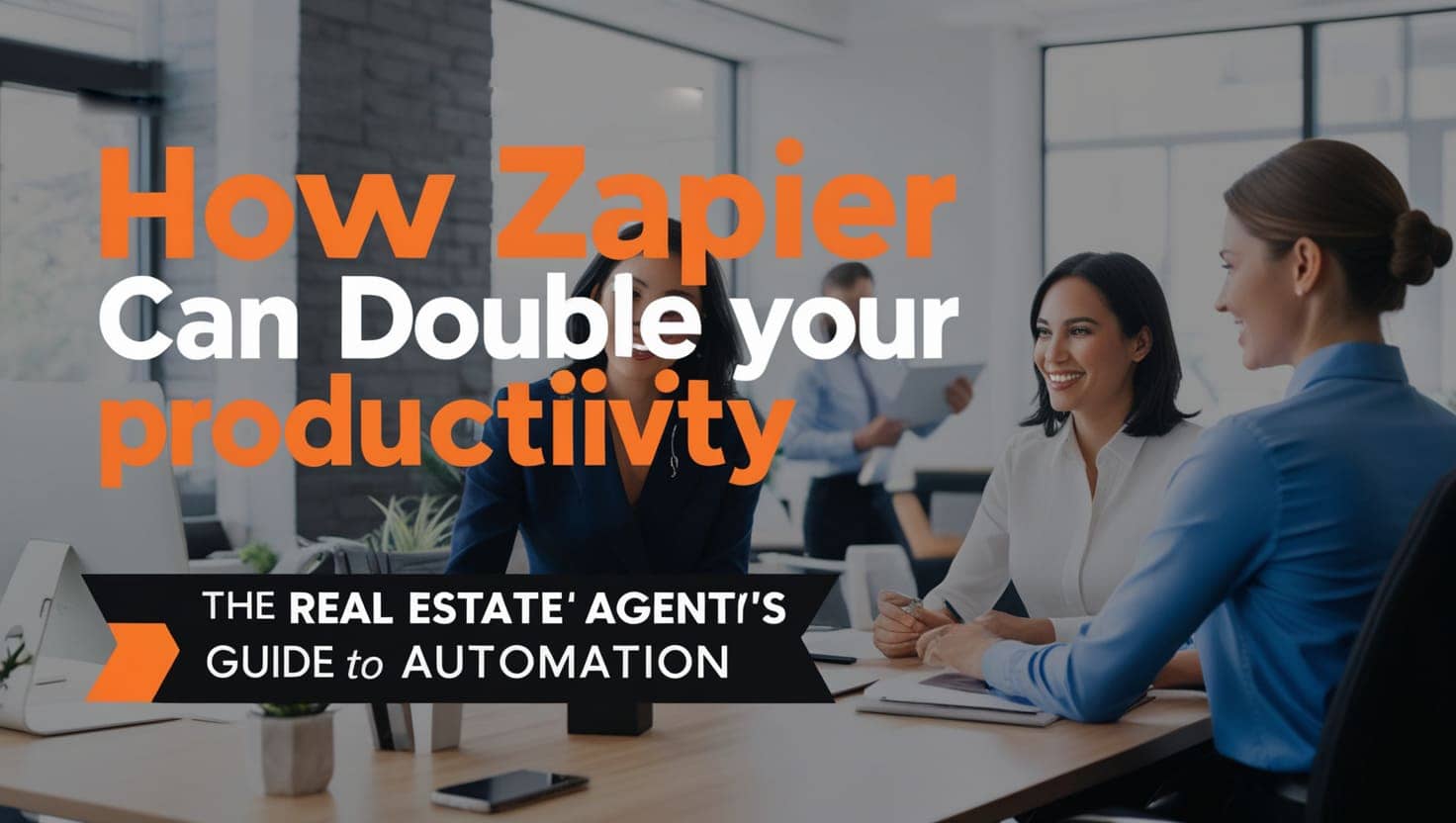
Real estate pros looking for ways to save time and boost efficiency will love Zapier. It’s one of those tools that seems small but makes a huge difference the moment you start using it. Imagine automating the mundane tasks you’re stuck with every day, like downloading files, saving contacts, or sending emails. Wouldn’t that be a game-changer? That’s precisely what Zapier does.
In this post, we’ll break down how to start using Zapier to streamline day-to-day operations, especially for tasks like handling internet leads, saving attachments, and syncing data between several platforms. We’ll also look into a few real estate-specific tasks that can be automated, such as lead management from Facebook ads and updating your CRM system automatically.
By the end of this, you’ll have a solid idea of how Zapier can help you run your business more smoothly while saving precious time.
Getting Set Up with Zapier
If you haven’t heard of Zapier before, think of it as a bridge that connects your favorite web services. It lets apps like Gmail, Facebook, and Google Sheets talk to each other. The goal is to take actions that you’re constantly repeating and automate them. It’s quick to set up, easy to implement, and very affordable.
Setting up your Zapier account is easy. Just head over to their website, and create an account. They offer free plans which are perfect for those starting out or experimenting with automations. Once you’re signed up, you’re taken to a dashboard, which is where the magic happens. Here’s where you’ll build workflows, or what they call “zaps.”

What is a “Zap”?
A “zap” in Zapier’s world is just a workflow. It connects two or more apps to perform an action based on a trigger automatically or on a schedule. For instance, you might want to send a Facebook lead straight into your CRM as soon as they fill out a form. That’s a zap.
Each zap consists of two parts:
• Trigger: The event that starts the automation (e.g., receiving a new Facebook lead).
• Action: The task that happens automatically (e.g., adding that lead to your CRM).
Sounds simple, right? But the amount of time it saves adds up fast—especially once you create more complex zaps with multiple actions.
Automating Internet Lead Generation
One of the most irritating things about managing Facebook lead ads manually is the lag between when the lead submits info and when you follow up. Leads can get cold in minutes. If you’re logging into Facebook, downloading an Excel sheet, and then importing it to your CRM, you’re losing valuable time.
Here’s where Zapier steps in. With just one zap, you can set things up so that every new lead from a Facebook ad is automatically sent to your CRM. No more spreadsheets. You can even schedule it to check for new leads every five minutes. This makes sure you’re following up with those leads ASAP.
To set this up, you’ll combine Facebook Lead Ads with your CRM (like Follow Up Boss or Firepoint). Here’s how to do it in simple steps:
1. Set the trigger: Select “New Lead” in Facebook Lead Ads.
2. Choose the action: Set it to “Create or Update Contact” in your CRM.
3. Sync the two: Zapier talks to your Facebook account and CRM, making the whole process smooth.
Now your leads flow straight into your CRM within minutes. Plus, you can set it up to send out automated responses via email to the new leads, making your follow-ups instant!
Automating Data with Gmail and Google Sheets
Handling email attachments can also get frustrating. You’ve probably had one too many instances where you missed sending a document or downloading an important file. With a zap, you can’t forget—or more importantly, you can prevent a cluttered inbox.
A popular zap involves automating Gmail attachments. You can set a zap where every time you receive a new email with an attachment, it gets automatically downloaded to your Google Drive folder. This eliminates the need to manually go through your attachments one by one, checking and downloading them.
Here’s another example: If you’ve got Gmail emails that you always need to log or track, you can set up a zap that sends those emails (or specific ones that meet a certain criteria) to a Google Sheet where the details are stored. This can be a huge time-saver for organizing specific emails like new inquiries or customer feedback.
Step-by-Step Zap for Gmail Attachments:
1. Trigger: Gmail receives an email with an attachment.
2. Action: Save that attachment in a specified Google Drive folder.
3. Result: All necessary files get saved automatically, organized and ready for you to access later.
This doesn’t just work for Gmail and Google Drive. You can hook it up with Dropbox, Trello, Evernote, and more.
Multi-Step Zaps: Doing More with One Trigger
Once you get comfortable with the basics, it’s time to explore multi-step zaps. With these, you don’t have to be limited to one action per zap. One trigger can lead to multiple actions. For example, any new Facebook lead can trigger actions to:
• Send the lead’s details to your CRM
• Add the contact to a mailing list like MailChimp
• Send you a notification via email or Slack
It’s a domino effect of productivity. This kind of automation is perfect for those juggling several apps daily.
Let’s break this down with a Facebook lead example:
1. Set the trigger: New lead on Facebook.
2. Action 1: Add the lead to your CRM.
3. Action 2: Add their contact info to a MailChimp list for future drip campaigns.
4. Action 3: Send yourself a text or email notifying you that a new lead has come in.
Instead of managing the lead three different times in three different systems, Zapier manages it all in one swoop.
Syncing with Your CRM
Everyone in real estate knows having a CRM that runs well is vital. Whether you’re using Follow Up Boss, Firepoint, Kunversion, or any other platform, speed is essential. Often, delays happen simply because we’re busy. Missed opportunities come from slower response times.
By setting up zaps connected to your CRM, you’re pulling in leads, automating follow-ups, and tracking everything—all without lifting a finger. Real-time lead syncing ensures your CRM is always updated, meaning no more logging into Facebook to download info or wondering if you’ve missed potential clients.
For example, if you’re using Firepoint, which doesn’t have a direct Zapier integration, here’s an easy workaround: You can send an automated email through Zapier to a specific contact parsing email address provided by Firepoint. Zapier will format the data and Firepoint will ingest it as a new lead.
Example of a Simple CRM Sync Zap:
• Trigger: New Facebook lead.
• Action: Automatically create or update a contact in your CRM.
You can even set it so that the lead gets a personalized “thank you” email or follow-up message as soon as they hit your CRM.
Syncing with Your CRM
Everyone in real estate knows having a CRM that runs well is vital. Whether you’re using Follow Up Boss, Firepoint, Kunversion, or any other platform, speed is essential. Often, delays happen simply because we’re busy. Missed opportunities come from slower response times.
By setting up zaps connected to your CRM, you’re pulling in leads, automating follow-ups, and tracking everything—all without lifting a finger. Real-time lead syncing ensures your CRM is always updated, meaning no more logging into Facebook to download info or wondering if you’ve missed potential clients.
For example, if you’re using Firepoint, which doesn’t have a direct Zapier integration, here’s an easy workaround: You can send an automated email through Zapier to a specific contact parsing email address provided by Firepoint. Zapier will format the data and Firepoint will ingest it as a new lead.
Example of a Simple CRM Sync Zap:
• Trigger: New Facebook lead.
• Action: Automatically create or update a contact in your CRM.
You can even set it so that the lead gets a personalized “thank you” email or follow-up message as soon as they hit your CRM.
Automate Your Email Workflows
It’s well-known that following up within minutes significantly increases your chance of closing a deal. But not everyone has the time to send personalized emails to every lead right away. Automating your email responses helps smooth over this gap.
Zapier allows you to set up email templates that go out instantly when triggered by a new lead, inquiry, or any other action you choose. Whether you want to send a thank-you email five minutes after somebody joins your list or send a piece of content immediately after they engage, automating this helps keep your prospects warm until you can follow up manually.
Quick Setup for Email Automation:
1. Trigger: New form submission.
2. Action: Use Gmail’s send email feature to instantly respond to the lead.
No more worrying if you forgot to respond quickly enough. Your email is already on its way!
Working with Premium Apps
Some of the apps you may want to connect in Zapier require a premium plan. For example, Facebook Lead Ads is considered a premium app. This just means that you’ll need to upgrade to Zapier’s starter plan (around $15/month) to use these integrations.
For many real estate agents, this isn’t a big deal. The cost is nominal compared to the time-saving benefits. Automating just your lead collection and follow-ups alone would pay for itself in time saved by the end of the month.
Avoiding Overwhelm: Keeping Things Simple
One of the mistakes that a lot of people make (and I fell into this trap myself) is trying to do too much too fast. Between CRMs, mailing lists, social media, and Google Sheets, it’s easy to feel scattered. You’ve got 10 systems talking to each other—and if you’re not careful, it can become overwhelming.
The best advice when starting out is to keep it simple. Find the one or two tasks you repeat daily or weekly that take up unnecessary time. Automate those first. Once those are running smoothly, then add more automations.
Zapier is great, but no tool can save you from complexity. You can set 20 zaps that automate every angle of your business, but if you’re not keeping a steady grip on your processes, it can get confusing. So, start smart, build on success, and keep it straightforward.
Zapier is the Swiss Army knife of automation. It’s easy to start small, and you can quickly scale as you get more comfortable with its power. Whether you’re syncing Facebook leads with your CRM, automating follow-up emails, or organizing data, this tool lets you focus on what matters—closing deals, not logging data.
The best part? It’s affordable. Even premium plans cost around $15 per month, which is nothing compared to the time it will save you. The real win, though, is how efficient it makes your entire operation. Once you’re automating those tedious daily tasks, you’ll wonder how you ever managed without it.
So dive into Zapier, explore what it can do for your business, and start saving yourself hours each week. Start small, keep it simple, and watch your productivity grow.